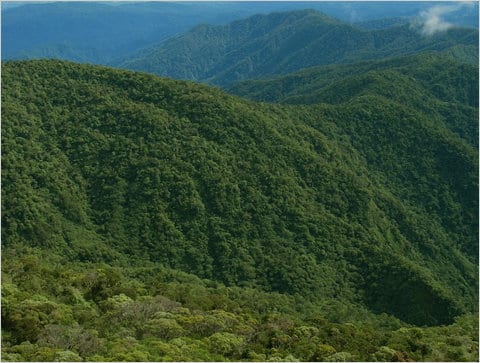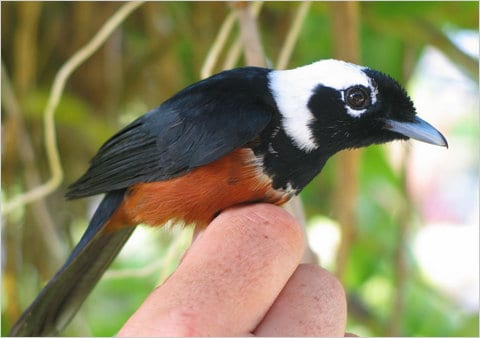
The highest point in the Solomon Islands, more than 8,000 feet above Henderson Field. The uplands of Guadalcanal are a spectacularly mysterious place that few have ever visited. These forests are part of the largest remaining contiguous tract of wet forest left in the insular tropical Pacific. Photo by Chris Filardi
Three short hours from the cosmopolitan city of Brisbane, Australia, and a world away, I have arrived in the Solomon Islands. Stepping from the crisp tubular world of jet travel into the familiar thickness of tropical air, I descend the gangway into a place that once echoed with the thunder and stench of the Battle of Guadalcanal, a place first visited by American Museum of Natural History biologists nearly a century ago during an expedition that really did change the world, and a place still alive in a timeless blend of biological and cultural wonder that inspired my career as a biologist.
I arrived here at Henderson Field on Guadalcanal nearly 15 years ago to study elusive forest birds. That was before I knew the details of the bloody battles that brought tens of thousands of American soldiers through this airstrip between 1942 and 1943, before I knew that my great-uncle preceded me here as a Marine, falling injured in the tawny hills.
For biologists, islands have always been illuminating places. In part, this reflects both the relative simplicity of island ecosystems and also the richly unique, and sometimes bizarre, turns that life takes on islands – think parrots behaving like big rodents, massive dragonlike lizards and miniature hippos, giant flightless dodo birds and tiny ground-foraging bats.
The Galapagos islands inspired Darwin’s brilliant and remarkably enduring explanation for how species change over time through natural selection, and it was islands – the Solomon Islands in particular – that helped to answer the great question his famous book left unanswered: what, really, is the origin of species?

In the late 1920s, Ernst Mayr, then a young scientist at the American Museum of Natural History, armed with insights from the newly emergent field of genetics, visited the Solomons as part of the epic Whitney South Sea Expedition.
In a flash of inspiration sparked by the high degrees of endemism (forms unique to single regions or islands) among Solomon birds, Mayr theorized that geographic isolation alone could drive one population diverging from another population until they became distinct species.
Geographic isolation as genesis, something islands have in spades: it was this that we first came to explore in the Solomons. Just as Ernst Mayr brought emerging genetic theory to bear on earlier ideas about speciation, we had new theoretical and technological advances at our disposal when we first arrived. Not only could we think about genetics, we could visualize and analyze actual DNA molecules. This enabled a new genetic measure of bird variation across geography, and to some extent over time. To do this, however, we needed to collect DNA, or samples of fresh tissue, from birds across their ranges in the Solomon Islands.
It has taken more than a decade of collaborative field and lab work, an enduring partnership with my fellow graduate student (turned wife and mother to our two children), and an incredible amount of wisdom, grace and partnership from Solomon Island naturalists and community leaders. We now have some emerging results that are again altering our sense of island biology.
For instance, we used to think islands received colonists through a one-way flow of diversity from overflowing continental systems. Molecular analyses are now revealing that island evolution is a two-way street, with colonists arriving on islands, evolving into wonderfully unique forms, and then often backtracking to reinvigorate continental diversity. This means that islands are engines of diversification in their own right and far more important to global patterns of diversity than we once thought.
All pretty cool, but one thing persistently troubles me. The patterns we have been addressing over the years are based primarily upon the birds of the lowlands. High above, there are seldom-visited islands within islands, mossy elfin cloud forests filled with endemic birds often known from only one or two specimens collected a century or more ago. And these are not just little brown birds, but huge forest-dwelling kingfishers, long-legged mouselike songbirds singing unknown songs, and montane-nesting seabirds whose nests have never been found. What will exploration of these poorly known islands within islands reveal?

Over the next several days I will run around the wonderfully real and gritty capital town, Honiara, in preparation to join a team of Solomon Island biologists on an expedition to the highest ridgeline on the island of Kolombangara – a place few people have visited in recent decades and a place unsurveyed by scientists.
It is a hard-won victory by indigenous landowners that these high-elevation forests are now part of a fledgling system of protected areas in the Solomons, and this trip is a long-awaited journey for me. But I first have to track down tarps and search out two prominent leaders from the area (both way easier said than done), follow up on a small mountain of requisite paperwork, and drink a cold Solbrew with a friend who is a master at helping me puzzle all of my gear into shapes that will fit into small planes, motor canoes and dugouts, and then on our backs – the steps between here and there.
